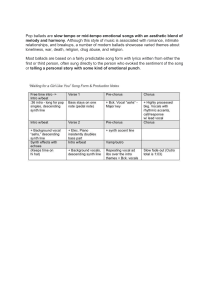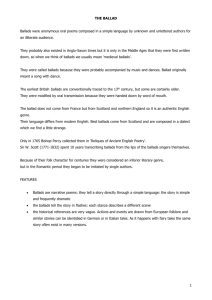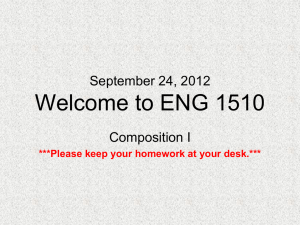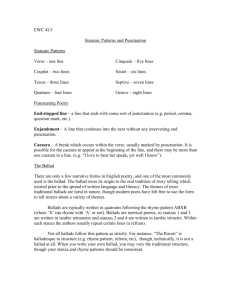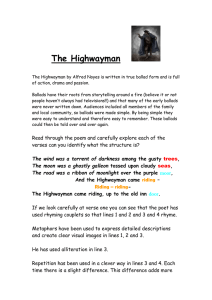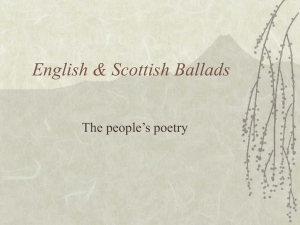Poetry Vocabulary PowerPoint
advertisement
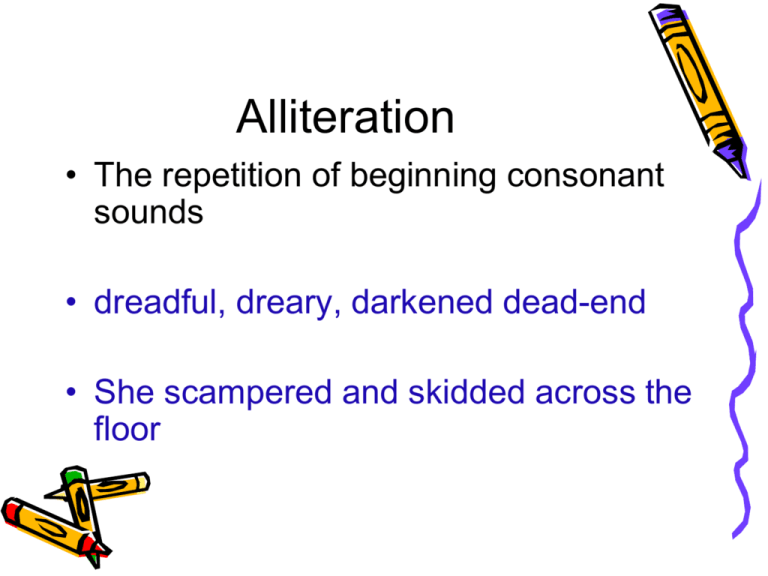
Alliteration • The repetition of beginning consonant sounds • dreadful, dreary, darkened dead-end • She scampered and skidded across the floor Diction • The choice of words a writer makes What difference is there between a: • A physician • A doctor • A quack Hyperbole • A description that exaggerates or overstates • He is the greatest human being ever to walk the earth • She hit the ball over the fence and to the moon Imagery • Using words to describe that appeal to the five senses in order to create a mental picture Imagery A host, of golden daffodils; Beside the lake, beneath the trees, Fluttering and dancing in the breeze. Continuous as the stars that shine And twinkle on the Milky Way Irony • Where an event occurs which is unexpected and in contrast to what is expected • The Olympic diving champion returned home with his five medals but was found dead in the jacuzzi. Metaphor Comparison between two unlike things, not usually compared, stating it as if it is that thing (not using “like” or “as”) • The road was a ribbon of moonlight • Her hair, a spider web of tangles Mood • The feeling or emotion created by the author (How it makes me feel.) • If the first line says “it was a dark, murky, and mysterious night” this creates a feeling of fear and uncertainty. Parallelism • The use of phrases or words that are similar in structure or meaning • Mary likes to hike, to swim, and to ride a bike while on vacation. • I’m happy with love, I’m filled with contentment. Personification • Using human(person-like) characteristics to describe an inanimate object • The wind gnawed at her dress • Hunger came knocking Repetition • The repeating of a word or phrase for effect • All we did was sit, sit, sit, sit on that cold, cold, cold, cold day. Rhyme • Similar sounds at the end of words • Door, floor, core, store, war, Rhyme Scheme • • • • • • The rhyming pattern of the lines aabb I want to run (a) In the hot sun (a) I must not cry (b) Even though I am not dry (b) Rhythm/Meter • The pattern formed by accented and unaccented syllables in a line of poetry ^ ^ ^ ^ • The boy went down the street today. ^ ^ ^ ^ • Twin-kle, twin-kle lit-tle star Simile • A comparison between two unlike things that uses the word “like,” “as,” “than,” or “resembles” • The moon appeared as a large drop of blood in the darkening sky. • He was as quick as a cat on a hot tin roof. Stanza • The organizational structure of lines in a poem (a paragraph in a poem or song) Down dropped the breeze, the sails dropped down, ‘Twas sad as sad could be; And we did speak only to break The silence of the sea! All in a hot and copper sky, The bloody Sun, at noon, Right up above the mast did stand, No bigger than the Moon. Day after day, day after day, We stuck, nor breath nor motion; As idle as a painted ship Upon a painted ocean. Tone • The attitude of the author toward the subject of the poem • Bitter and sarcastic tone • Matter-of-fact tone • Disrespectful tone • • • • Mary had a little lamb a It’s fleece was white as snow b And everywhere that Mary went c The lamb was sure to go. b Free verse • Poetry that has no regular rhyme or rhythm Life is like a broken-winged bird Too soft to handle Too hard to hold Analogy • Comparison made between things that are alike in some way (opposites, relationship, part-to-whole) • Hot:Cold Big:Small Symbol • Something on the surface level has one meaning, but which also has another meaning • Light symbolizes knowledge • Sword symbolizes justice Allusion • A reference to someone or something that is known in history or literature • The Garden of Eden could not have been a happier place . . . • His was the love of Romeo that . . . • The snow-covered tree-tops glistened as the bright sundrops sprinkled across their tips. Ballad Here is a list of the characteristics of ballads: • Most ballads have a narrative form. • Ballads tend to have a distinctive verse formQuatrains. (4 line stanzas) • Ballads have refrains-with four stresses per line—general effect is musical. • Most ballads contain dialogue. Ballad • The common rhyme scheme of many ballads is (abcb) with ballad stanza lines 2 and 4 rhyming. • Ballads tend to be extremely concise and tend to recount one episode. • Common themes include tragic love themes, history, supernatural, unbelievable incidents, tragic domestic stories, etc. •
